The Danevirke and Offa’s Dyke
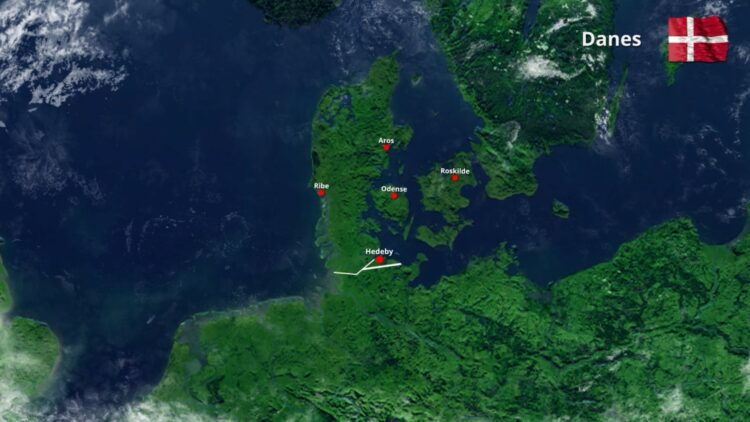
by Andrew Hamilton
DENMARK OCCUPIES the Jutland Peninsula.
In the south, where the peninsula joins the mainland, the prehistoric Danes constructed a massive fortification known as the Danevirke (earthwork of the Danes) across the Schleswig isthmus separating the peninsula from the rest of continental Europe.
Called “the most considerable surviving antiquity in Denmark,” construction of the wall began in the pre-Viking Iron Age, around 500-650 AD. Over hundreds of years the fortifications, in continuous use, were constantly improved.
Due to a 19th-century border change, the Danevirke today lies in Schleswig-Holstein, Germany, not Denmark.
Psychologically, the Danevirke served as a mental and cultural barrier separating Denmark from the great European landmass to the south, a potent symbol of the Danes, their language, and culture. They remained ethnically, linguistically, historically, psychologically, and politically integrated with the Nordic region.
Remnants of the fortification can still be seen with the naked eye, though they lack the epic appearance they possessed a millennium ago when bricks, stones, and castle-wall-style structures made of wood topped the surviving, if diminished, earthworks.
Today the wooden fortifications are gone, the earth and stone ramparts have eroded, in some places leaving them scarcely higher than the surrounding countryside. The ditches in front of the wall have become shallower as they’ve filled in over the centuries.
As one writer notes, “Initially, the Dannevirke were only high earth-works, but by the mid-700s the walls had been reinforced by massive wooden fronts, along with towers and, in some places, a stone wall. At times during the Middle Ages, places along the works were topped by palisades and finely worked masonry.”

The massive fortification was constructed from thousands of stones and miles of earthworks laboriously shoveled by masses of men. The wall was roughly 19 miles (30 km.) long, 16 feet (5 m.) high, and 65 feet (20 m.) wide. These measurements refer to the earthworks, stone, and brick base, not the lumber walls and other structures sunk into and rising above them, which vanished long ago.
The Danevirke was not a single, unbroken wall extending from the Kattegat sea in the east to the North Sea in the west, but rather a series of defensive embankments connecting large sections of impassable marshlands and dense forests that served as barriers to foreign invasion. The construction was thus seamlessly integrated with natural obstacles.
When Charlemagne established his Frankish Christian empire, he launched a series of campaigns against the Saxons to his northeast, and by 800 had defeated them and converted the chiefs and their followers to Christianity.1
This directly exposed the Danes to the north, so Godfred, a local king in southern Denmark, greatly expanded and strengthened the Danevirke as a defensive barrier.
He also transformed the eastern Danish port of Hedeby, three miles south of the modern town of Schleswig in the German province of Schleswig-Holstein, into the largest and most prosperous economic outpost of the Viking era. The defensive wall constructed around Hedeby was part of the Danevirke.
Situated on the borderland between the Frankish Empire to the South and the Danish kingdom to the North, Hedeby for more than three centuries — the entire Viking era — was the primary trading hub between Scandinavia and continental Europe, the Byzantine Empire, and the Mediterranean seaports, as well as a key link between the North Sea and the Baltic Sea.
The Hærvejen (“army road”) was the main north-south route through Jutland, parts of which date back to 4000 BC. Primarily a trade route, it ran along the watershed of the Jutland Peninsula from Viborg, Denmark through Schleswig-Holstein to Hamburg, Germany. The sole gateway through the Danevirke was constructed for the Hærvejen near Hedeby. The gate was excavated by German archaeologists in 2010-2014.
Offa’s Dyke
The Danevirke was listed as a UNESCO World Heritage Site in 2018. (UNESCO, Archaeological Border complex of Hedeby and the Danevirke.)
An easy way to view a bureaucratic application (in English) requesting such a formal designation is to glance through the 18-page 2010 British application for Offa’s Dyke, the ancient boundary between England and Wales. The Dyke, which has still not been added to the list, is similar to the Danevirke and dates from roughly the same time period.
Considerably longer at 82 miles than the Danevirke, the Danish fortification is nevertheless twice as high. The width of the two is about the same.
The last page (p. 18) of the British application lists the UN criteria that must be met to obtain the World Heritage Site designation.
The first 8 or 9 pages briefly describe Offa’s Dyke and its historical and cultural significance. Page 8 states that
The only current World Heritage Sites which have a nominal similarity to Offa’s Dyke are the small group defined as ‘fortified boundaries’. These include the Frontiers of the Roman Empire (Hadrian’s Wall, Antonine Wall, German Limes Frontier) and the Great Wall of China.
The Danevirke is not mentioned because Britain’s 2010 application predates its 2018 addition to UNESCO’s list. The same page nevertheless adds:
Offa’s Dyke can be compared with other boundary dykes known across the former Anglo-Saxon lands (including Wat’s Dyke, Wansdyke and Devil’s Dyke in the UK and the Danevirke in Denmark). Offa’s Dyke is by far the longest and most distinctive of these structures, the only one associated with a known monarch and a clear context.
The Dyke has a notable contemporary feature the Danevirke lacks. Offa’s Dyke Path, which opened in 1971, is a beautiful 177-mile British National Trail for hikers. Britain’s UNESCO application expresses concern that “The ancient monument [the wall itself] is now often seen as secondary to the modern path.”
Just as the Danevirke powerfully reinforced the ethnic identities of Nordic Danes (and, more broadly, Scandinavians) on one side and Germans on the other, Offa’s Dyke had the same effect on the Welsh and English respectively:
In the centuries after Offa, the dyke exerted a lasting influence on the way the people living around it came to define their cultural identity. Despite the lasting legacy of Offa’s Dyke for English and Welsh communities alike, there is limited [contemporary] public awareness of the monument and its remarkable link to modern ideas of national identity.
Offa’s Dyke connects the culture of the ancient Anglo-Saxon and British peoples with the culture of living English and Welsh peoples. It has Outstanding Universal Value not just as a unique evidence of the cultural origins of modern Europe, but as rare monumental evidence of the origins of cultural identity generally.
Offa’s Dyke is directly associated with the development of profoundly rooted ideas of English and Welsh cultural identity. Over the last thousand years, the enduring landscape presence of the dyke has continually re-affirmed the living tradition of English and Welsh origins for the peoples on either side of the monument. — Excerpts from UK, UNESCO World Heritage Site application, 2010.
Generalized, these principles apply to the Danevirke as well.
1864

The perplexingly complex history of the German province of Schleswig-Holstein is intimately tied to the story of Denmark and the Danevirke.
Lord Palmerston, the most famous foreign secretary of 19th century Britain and twice Prime Minister, said in Parliament that the history of Schleswig-Holstein was so complicated that only three men ever fully understood it: Prince Albert (Queen Victoria’s husband), who was dead; a professor who went insane; and Palmerston himself, who had forgotten it.
Briefly, as the hyphen suggests, the region consisted of two Danish duchies, Schleswig in the north and Holstein to the south. Holstein, in turn, bordered the German Confederation.
Schleswig had northern and southern sections. By the early 19th century Holstein’s population was almost entirely ethnically German, Schleswig’s part Danish and part German.
During the revolutions of 1848, national frictions led to the First Schleswig War (1848-1851) between Denmark and the Kingdom of Prussia. As a result, the Danevirke fortifications were partially restored, strengthened, and equipped with artillery installations by Denmark in 1850 and 1861.
Subsequently, Prussian Prince Otto von Bismarck orchestrated the Second Schleswig War, an attack on Denmark by a Prussian-Austrian army. Denmark lost in 1864, the last full year of the American Civil War. The Scandinavian nation was forced to permanently cede Schleswig-Holstein to Prussia — the first step in Bismarck’s unification of modern Germany. The ancient Scandinavian sites of Hedeby and the Danevirke have remained in German hands ever since.
To the shock of the Danes, for whom the ancient bulwark had tremendous symbolic significance, the country’s eccentric commander-in-chief, General Christian de Meza, a dark-visaged Sephardic Portuguese half-Jew, abandoned the Viking-era wall after two battles and ordered his 40,000 men with their cannons and 10,000 horses to retreat northward.
With this defeat Denmark lost a third of its territory and 40% of its population. Many Danes whose families had lived in the region for centuries moved north to Denmark; others emigrated to America. Northern Schleswig, whose population remained majority Danish, was returned to Denmark by a plebiscite in 1920.
The resulting national trauma was so great that in Denmark the conflict is not called the Second Schleswig War or the German-Danish War, but simply “1864.”
A fictional 8-episode TV drama funded by the Danish government about the conflict called 1864 — the most expensive production not only in Danish, but in Scandinavian film and television history — was broadcast on state-owned channel DR1 in 2014. Based on two books by a journalist and academic in Denmark with the un-Scandinavian-sounding name Tom Buk-Swienty, it was also shown on television in Sweden, Britain, Ireland, France, Germany, and Australia.
Readers interested in a lengthy analysis of the production can consult “The Battle of Dybbøl Revisited: The Danish Press Reception of the TV-series 1864,” Kosmorama (November 17, 2015), by Swedish film studies professor Erik Hedling. The article actually covers much more than media reaction to the series.
Predictably, the show instructed Danes and Europeans that stupid nationalism was responsible for Denmark’s defeat, and peddled explicit anti-White propaganda and degenerate sexual themes as well. Buk-Swienty pointed to General Christian de Meza as the greatest hero of the entire drama.
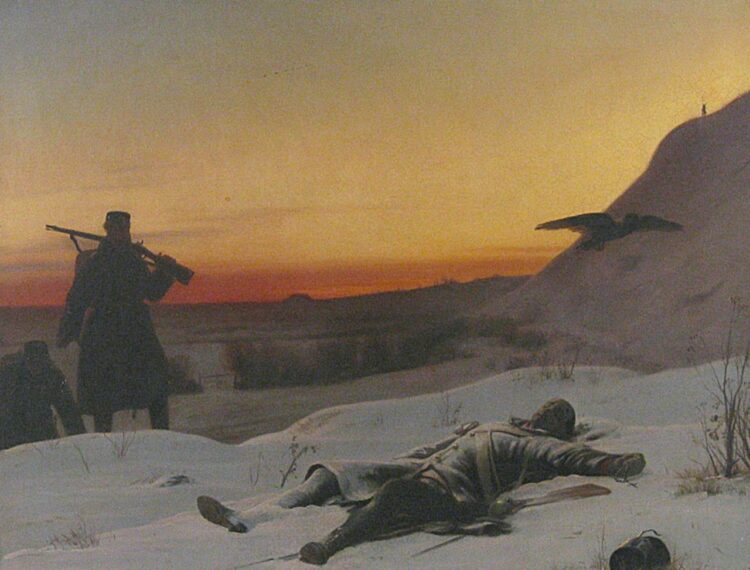
The Danevirke and the Invasion of 1944
At the beginning of WWII Hitler had not contemplated invading the Scandinavian countries.
However, the German-Soviet Nonaggression Pact (August 23, 1939) that split Poland between Germany and the Communists contained a secret protocol allotting Finland and the Baltic states (Latvia, Lithuania, and Estonia) to the Marxists. The latter three nations thereby lost the independence they’d gained in 1919 after repelling the initial Bolshevik invasions of their homelands, and were permanently absorbed into the USSR.
Under shelter of the protocol the Soviets also attacked Finland with 1 million men along several fronts. Despite putting up a valiant fight, the vastly outnumbered and outgunned Finns, who were denied assistance by “democratic” Britain and France, lost the 1939-1940 Winter War. Russia seized Finnish territory in the east and the remainder of the realm was subordinated to the Soviet Union.
In early 1940 intelligence reports revealed that Britain was preparing to occupy Norway.
Even though Germany had signed a 10-year non-aggression pact with Denmark’s Social Democratic government the year before, Hitler invaded both neutral Denmark and Norway simultaneously to protect Germany’s northern flank. Sweden remained neutral throughout the war.
The Germans occupied Denmark from April 1940 to May 1945. In August 1943 martial law was declared and King Christian X was placed under house arrest.
After the Allied invasion of Normandy, France in 1944, the Wehrmacht (Germany’s combined military forces: army, navy, and air force) prepared for a possible invasion of the west coast of Denmark. Nine thousand construction workers were brought to Schleswig-Holstein to transform the Danevirke into a north-facing tank barrier.
An intrepid Danish archaeologist specializing in Aryan antiquities, Søren Telling, got wind of the plan and became alarmed by the threat it posed to the historical integrity of the Danish landmark.
An ardent pro-White anti-Communist, Telling had fought in the Estonian War of Independence (1918-1920) against Communist Russia, and been awarded the Estonian Cross of Liberty. In March 1935 he joined Frits Clausen’s National Socialist Workers’ Party of Denmark (DNSAP) and served on Clausen’s personal staff.
Moving in late 1938 to Kiel, the capital of Schleswig-Holstein, Telling acquired German citizenship and became an assistant to noted German SS archaeologist Herbert Jankuhn, who, beginning in 1930, and from 1938 with the help of the Ahnenerbe, organized large-scale excavations of Viking-era Hedeby, the eastern anchor of the Danevirke. It was one of the biggest archaeological projects in the world. Jankuhn’s work at Hedeby so impressed SS chief Heinrich Himmler that in 1940 he appointed him head of the Excavation and Archaeology Department Ahnenerbe.
It is unclear whether Telling accompanied Jankuhn to the Crimea in the summer of 1942 behind the 5th SS Panzer Division Wiking to conduct excavations at Mangup, the capital city of the lost Crimean Goths.
Back in Schleswig-Holstein, Telling oversaw several excavations, including one at the Kovirke, an early section of the Danevirke, and coordinated archaeological preservation activities where German military construction was taking place or the Allies were bombing.
Søren Telling urgently telephoned the SS and spoke for over an hour to Wolfram Sievers, the managing director of the Ahnenerbe (hanged by the US in 1948 at age 42 in “War Criminal Prison No. 1” — Bavaria’s Landsberg Prison, where Hitler had been incarcerated), and to Heinrich Himmler. Himmler verbally authorized Telling to order military commanders to avoid disturbing the Danevirke as much as possible, saying a written order by telegram might take a few days to arrive due to heavy shelling. (The telegram dated November 2, 1944 arrived two days later.)
Though military leaders were initially reluctant to obey Telling, they were hesitant to risk violating an SS order if one had been issued. Telling’s action saved the Danevirke from possible destruction, as the Wehrmacht thereafter worked around the existing remains.
The Danevirke maintained a strong military hold over the minds of men until at least 1944, 1,400 years after its initial primitive construction, powerful testimony to the influence of select geographical landscape features on human affairs, and the wall’s historical significance and enigmatic quasi-spiritual presence.
Note
1 Among other things, Charlemagne imposed an early form of “gun control”: “Who made the best swords? There is no doubt about the answer, the Franks. For this there is literary evidence. The repeated embargo on the export of swords and other weapons, imposed by Charlemagne and [his grandson] Charles the Bald, even to the extent of the death penalty for infringement. Charlemagne’s ban applied to both east and north — both the Avars [a Mongolian tribe] and the Vikings. Charles the Bald’s prohibition was expressly directed against the Viking market: why should his craftsmen supply these blood-thirsty robbers with the choicest weapons in the world?” – Johannes Brøndsted, The Vikings (Penguin Books, 1965).
* * *
Source: Author


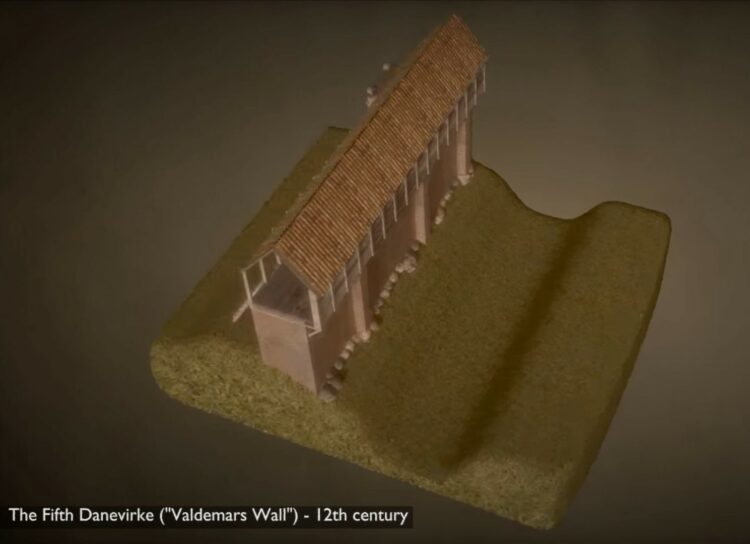
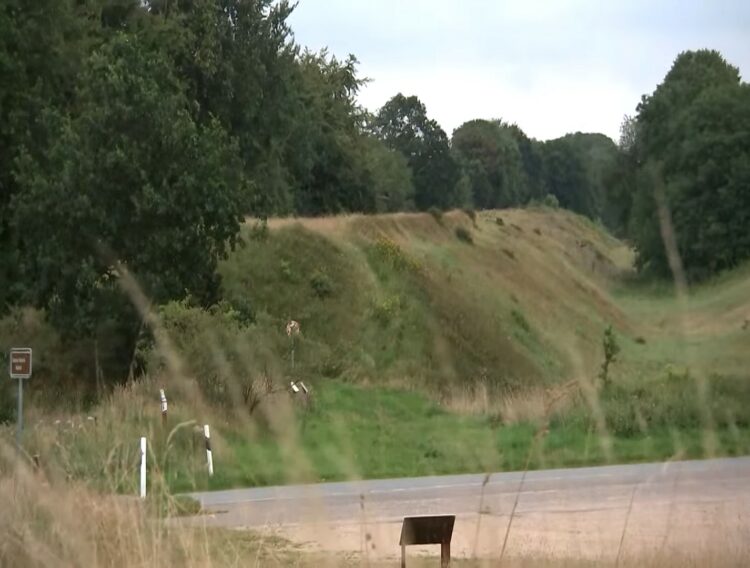




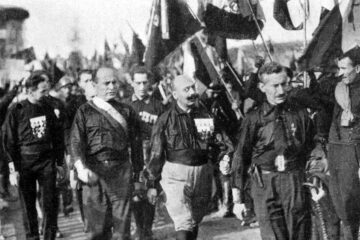
I appreciate this history that I never knew about. It speaks to me, with my substantial Danish ancestry. Wow. Those were real men back in those days. The modern Danes are sort of an embarrassment to me, sadly.
Norway was occupied, as far as I know, mainly for the strategic reason to bypass the British naval blockade (by sea mines) of the seaways into the Atlantic to the north. It also opened up strategic possibilities towards Russia, with which Norway shares a border section at the North Cape. https://en.wikipedia.org/wiki/Blockade_of_Germany_(1939%E2%80%931945)
https://www.youtube.com/watch?v=2ZLhqlOH-UE
https://bunkermuseumhanstholm.dk/en/
Buk-Swienty pointed to General Christian de Meza as the greatest hero of the entire drama.
That is not Buk-Swienty’s doing, but the Degenerate Commie Swine (DCS) in DenMarx Radio, the national broadcaster. Jew or not, de Meza was an excellent officer despite his eccentricities, but he was only there for the ouverture. The retreat from Dannevirke was quite obviously the correct move and an unequivocal defensive victory, which was why De Meza cut the telegraph line to Copenhagen so the DCS in government couldn’t countermand his orders.
How To Defend Denmark:
1) Secure local naval superiority
2) Establish three flanking positions on the east coast of Jutland
3) When Ze German comes, let him take Jutland
4) Have the navy shuttle troops back and forth between the flanking positions, opportunistically attacking Ze German supply train at its weakest.
This recipe – not Dannevirke – has kept Denmark independent for centuries. But in 1864, the shitforbrains government decided that the symbolic value of Dannevirke was so great it needed defending, despite the decrepit relic not having been maintained for more than a century.